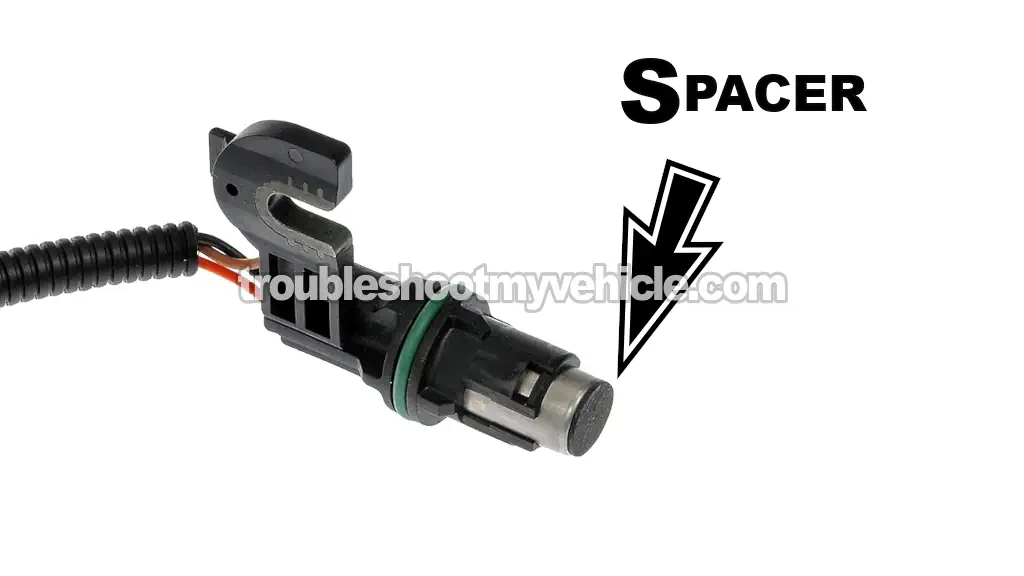TEST 2: Making Sure The CMP Sensor Is Getting 8 Volts

Before the CMP sensor can generate and send a signal, it needs a solid voltage supply from the PCM.
In this test, we'll focus on terminal #1 of the 3-wire connector, which carries that voltage (8 Volts).
Terminal #1 connects to the orange (ORG) wire of the CMP sensor connector.
You'll use a multimeter to check for power while the key is ON (engine not cranking).
This is what you need to do:
- 1
Disconnect the CMP sensor from its connector.
- 2
Attach black test lead to the negative (-) battery terminal.
- 3
Select DC Volts on your multimeter.
- 4
Turn the key to the RUN position but don't crank the engine.
- 5
Carefully probe terminal #1 of the CMP sensor connector with the red multimeter test lead.
- 6
The multimeter should display between 7 and 8 Volts DC.
Let's connect the dots and see what your result means:
CASE 1: 7 to 8 Volts present at CMP sensor. Great! That's what we want to see.
With sensor power confirmed, the next step is to verify the sensor has a good Ground path. Go to: TEST 3: Making Sure The CMP Sensor Is Getting Ground.
CASE 2: No voltage reading. Check your meter leads and test setup one more time.
Still nothing? Then the CMP sensor isn't getting voltage, which usually points to an open wire somewhere between the PCM and the sensor connector.
Although it's beyond the scope of this tutorial to troubleshoot this missing voltage, your next step is find out why it's missing and restore it to the circuit.
TEST 3: Making Sure The CMP Sensor Is Getting Ground

Up to this point, you've already confirmed:
- TEST 2: The sensor is getting power.
- TESTS 1: It's not outputting a signal.
That leaves us with one more test to do and that's to make sure the CMP sensor has Ground.
The wire that delivers Ground (from the PCM) to the CMP sensor is the black with light blue stripe (BLK/LT BLU). This wire connects to terminal #2.
NOTE: It's absolutely critical that you don't apply 12 Volts to this wire —or you'll deep fry the PCM. To safely check for a proper Ground connection, we'll use your multimeter in Volts DC mode for this final test.Let's get going:
- 1
Unplug the CMP sensor.
- 2
Connect the red multimeter test lead to the battery's positive (+) terminal.
- 3
Select Volts DC mode.
- 4
Turn the key to the RUN position but don't crank the engine.
- 5
Touch the black multimeter test lead to terminal #2 of the CMP connector.
Terminal #2 should connect to the BLK/LT BLU wire of the connector. - 6
Your multimeter should show around 10–12 Volts DC.
OK, let's interpret your result:
CASE 1: Voltage reading is 10–12 Volts DC. This means the CMP sensor's Ground circuit is working correctly.
If the sensor is getting power (TEST 2) and NOT generating an ON/OFF signal (TEST 1), then it's officially toast and needs to be replaced.
NOTE: If you're installing a new sensor, see: Installing The CMP Sensor: Air Gap Clearance.
CASE 2: No voltage appears on the meter. Double check your test connections and repeat the test.
If there's still no voltage displayed, the BLK/LT BLU wire isn't providing a path to Ground.
This is often due to a broken (open) wire between the CMP connector and the PCM —the CMP sensor itself if OK.
Although it's beyond the scope of this tutorial, your next step is figure out what the issue is and resolve it.
Installing The CMP Sensor: Air Gap Clearance

When installing a new CMP sensor, you'll notice a paper spacer attached to its tip. This paper spacer approximately 0.020 inches (0.5 mm) thick.
If this spacer is missing —which is often the case when reusing an old sensor— it's critical that you buy a new one or create one before installing the sensor.
If you rather buy one, here's the link:
- Walker Products 235-1378 CMP Sensor Spacer (at: amazon.com).
If you want/need to make your own, cut out small circles from index cards and glue them together until you reach the correct thickness —0.020 inches (0.5 mm).
This DIY spacer not only sets the correct gap but also provides the necessary clearance so you can tighten down the CMP sensor bolt securely.
Just be sure to match the spacer thickness as closely as possible —the correct air gap is critical to avoid damaging the sensor when cranking the engine.
More 3.3L V6 Chrysler, Dodge, And Plymouth Minivan Tutorials
You can find a complete list of 3.3L V6 Chrysler, Dodge, and Plymouth minivan tutorials in this index:
Here's a small sample of the tutorials you'll find in the index:
- P0171 Diagnostics (1996-2010 3.3L V6 Chrysler, Dodge, And Plymouth Minivan).
- P0420 Diagnostics -Catalytic Converter Tests (1996-2010 3.3L V6 Chrysler, Dodge And Plymouth Minivan).
- How To Check For Vacuum Leaks: Carb Cleaner Spray (1991-2010 3.9L V6 Chrysler, Dodge, And Plymouth Minivan).
- How To Test For A Blown Head Gasket (1991-2010 3.3L V6 Chrysler, Dodge, And Plymouth Minivan).

If this info saved the day, buy me a beer!

